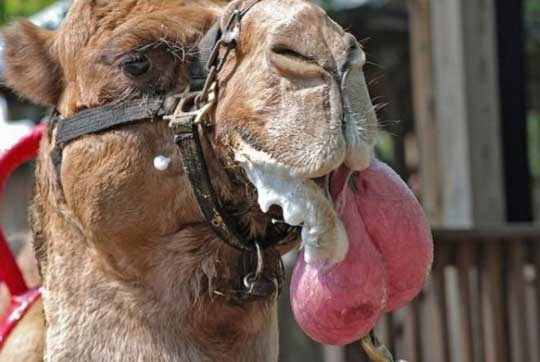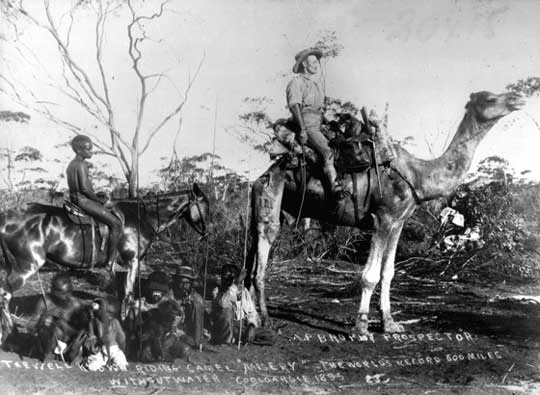|
Okay, for today's Awesome Animal, it seems appropriate to feature an animal that plays an important role in Bridgers 2 (which is being released on June15!). When our bridgers arrive in their new alternate version of Earth, they find themselves in the midst of a herd of large, hump-backed, drooling, lip-smacking creatures that resemble the camelops, which happens to be extinct on our own version of Earth. So what the heck is a Camelops? As you can probably tell by the name, the camelops was a type of camel. These critters were quite large, standing over seven feet tall at the shoulder and weighing 1,800 pounds (800 kg). They roamed over most of western North America, appearing about three to four million years ago and finally going extinct very recently (about 11,000 years ago). Amazing facts about Camelops (and Camels) Most people think of camels being in the deserts of Asia and Africa. But actually, camels (and their close relatives, llamas) originated in North America about 44 million years ago. By the way, horses originated in North America, too. Camels and horses gradually migrated to Asia over the Bering Strait (which, of course, is now underwater). We don't know if the camelops had a hump on its back. Why? Because everything we understand about these extinct animals comes from fossils. The hump on a camel's back is made of soft tissue (not bone), and soft tissue is rarely preserved in fossils. So, they may have had humps, like the modern camels, or they may have been humpless, like their other close relatives, llamas. The result of this is that some artists create them with long fur and humps, and others create them with short fur and no humps: The camelops was highly adapted for running and traveling great distances in open grasslands. Based upon fossilized tracks of early camels and upon bone structure, we know that they had a distinctive "pacing gait," in which the two legs on each side move at the same time (the two right legs move forward, then the two left legs). This gait is very efficient, allowing long-distance travel with less energy consumption. These camels liked to hang out with early horses and bison. Their fossils are often found together. Maybe this was because there was more safety from predators in large numbers. Or maybe simply because they liked to graze on the same plants. We don't know for sure why the camelops went extinct. It happened at about the same time that many other large North American mammals disappeared, including the mastodon, horses, llamas, and many others. This mass extinction could have been the result of climate change. But many scientists think it may have been caused by the spread of humans that hunted big game. Humans migrated to North America across the Bering Strait and then spread out to the south and east. These humans are known to have used spears with sharpened stone tips, as well as other stone tools. There is still little definitive evidence that humans caused the extinction, but it seems very likely. Another thing we're uncertain about regarding camelops anatomy is the mouth and throat. The males of today's Arabian camel (also called the dromedary) have a strangely modified soft palate that they can hang out the side of their mouth when they are ready to mate. This astoundingly grotesque structure is called a dulla, and the females find it irresistible, especially when accompanied by massive drooling and a loud grunting vocalization. Check out this video of a camel extending its dulla! Anyway, since the dulla is a soft body part, we don't really know if the male camelops had these. The word camel comes from the Arabic word, gml, which has the literal meaning, beauty. Hmm... whoever came up with the name probably wasn't looking at a camel with its dulla hanging out. Speaking of the dromedary (Arabian camel), these camels once lived in the wild in and near the Sahara Desert. But they were domesticated in the Somalia area about 4,000 years ago, and by 2,000 years ago, there were no more dromedaries living naturally in the wild. Oddly, though, in 1840, dromedaries were imported into Australia to be used as work animals in the dry areas of the outback. Over the decades, some of these camels were released into the wild, and now the population of feral camels is estimated at 300,000 to over 600,000. This is currently the only population of breeding dromedaries exhibiting wild behavior in the world. The photo below is of an Australian prospector riding a camel that held a world record for distance traveled without once drinking water. How far? Six hundred miles! So, the Camelops (and camels in general) deserves a place in the W.A.H.O.F. (Wicked Animal Hall of Fame). FUN FACT: The word wicked first meant, well... wicked (evil or morally bad). But in the last few decades younger people have started using it to mean wonderful, great, or masterful (as in, "I passed my biology exam. Wicked!"). It can also be used as an adverb to add emphasis to whatever you're describing, such as, "That's wicked cool!" So, wicked is another way to say awesome! Photo Credits:
Camelops Digital Rendering #1 - Philip Edwin Camelops with Hump (left image) - Canadian Museum of Nature Camelops without hump (right image) - Pinterest Native Americans hunting Camelops - Paleonet Camel dulla - Clay Walker via Digital Journal
1 Comment
|
Stan's Cogitations
Everyone needs a creative outlet. That's why I write. Archives
July 2024
|






 RSS Feed
RSS Feed